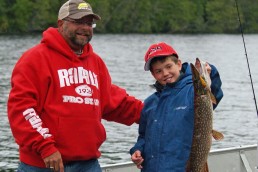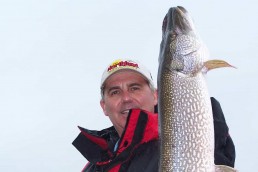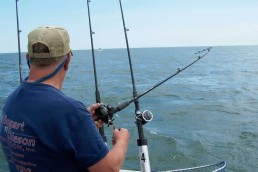Track Down Your Biggest Pike Ever This Summer
SHARE THIS POST
The northern pike is one of the most unique predators on the planet. And Esox luscious has a veracious appetite and is not picky.
The torpedo-shaped bodies of these plunderers are made for hunting. They also have eyes positioned near the top of their elongated head so they can easily zone in on their victims from afar. And they have a mouthful of razor-sharp teeth set at an angle within their bony jaws that doesn’t allow their quarry any hope of escape. They are quick, attacking prey in mere seconds and can sabotage them using stealth.
But even with such a ferocious reputation, there are certain times of the year when even lakes loaded with northern pike seem to be void of the species.
No, they didn’t just disappear or lose their teeth and are refusing to eat. They did, however, move from the shallows and into deeper, colder water, and are feeding well on the other species of fish that too have migrated into the depths for a little reprieve from summer’s sweltering heat.
With the right lure properly in the right place, catching a trophy northern pike can be a reality rather than just a dream.
Pike can thrive in just about any kind of water—oligotrophic (large, deep, cold) natural lakes, mesotrophic (shallow, warm,) lakes and reservoirs or rivers with clear or stained water.
Where you find the biggest of these beasts will depend on the type of waterway you are fishing.
Deep, yet high
In oligotrophic lakes, pike may suspend and feed on herring, shiners, whitefish and shad in the upper third layer of the water column. More often than not, when I am trolling large Rapala crankbaits for suspended northerns, I’m not so much worried about marking these marauders on my Lowrance as I am with schools of forage fishes. But baitfish will often scatter out from under my boat as I pass over them (especially so in clear water). This is why I like to use the StructureScan HD feature, which allows me up to 600 feet of side viewing in one direction (300 feet each direction if looking out both left and right) in high detail that’s easy to read and see where baitfish are bunched up. I can even add an icon over what I see on the screen so that I can pinpoint the exact location of the forage—even hundreds of feet away—turn and troll my lure right through them on the next pass.
After that I get my crankbaits in right front of the fish. I troll them behind one of my in-line planer boards. The reason I pull them behind planer boards is to get the lures out from behind the boat and into the strike zone of fish unaware of my presence.
I pretty much use the same equipment for northern pike that I do when trolling for suspended walleyes, which include Fenwick’s Eagle Telescopic Trolling rod and an Abu Garcia line-counter spooled with 12-pound-test Berkley Trilene XL monofilament. And if I need to get my crankbaits deeper yet, I’ll have a reel spooled with Sufix’s 832 Advanced Lead Core, which I’ll use with a 7-foot-long leader of 12-pound-test fluorocarbon line.
The outer limits
In smaller mesotrophic lakes—including tannic-filled lakes in Canada such as Granit Lake—you will see me targeting pike with both trolling and casting techniques.
Are you enjoying this post?
You can be among the first to get the latest info on where to go, what to use and how to use it!
Although the equipment will most likely be the same when I am trolling in the Canadian bush as anywhere else, my crankbait selection tends to be slightly different here. This is because the lakes are shallower and often packed with weeds, so I use lures that don’t dive quite as deep, like Original Minnows, Shallow Shad Raps and X-Rap Shad Shallows.
When casting for pike, I’ll use those same crankbaits, as well Blue Fox spinners, Northland Fishing Tackle’s Magnum Series Reed-Runner spinnerbaits and their Forage Minnow casting spoons.
When using Rapalas, I’ll use a medium-action Fenwick HMG spinning rod and ABU Garcia reel filled with 10-pound-test Berkley FireLine. When using the spinners and spoons, I’ll beef up my equipment to medium-heavy spinning gear and use 14-pound test Berkley Trilene XT.
If bite-offs and lost lures become an issue, I’ll use a short (about 6 inches) piece of Terminator Single Strand Titanium Leader in 20-pound-test. This leader material can be tied with a clinch or Albright knot and is thin enough not to impede the action of your lure.
When targeting northerns in shallow lakes, it’s best to look to the outer edges of weed beds that are adjacent to the deepest water in main-lake basins or nearest to the mouth of bays. Sunken islands, saddles and steep breaks near points are always worth a look as well.
Twist and (don’t) shout
One of the many reasons many anglers don’t like catching pike is because they never give up a fight—even after they’re in the net and on the floor of the boat.
There are several items you can use to make life easier after landing.
The first item is for during the landing procedure, and that’s a Frabill net with “Crankbait Net” webbing. It’s the unique design of the coated mesh that allows a pike to twist up in the netting, then unroll and be easily removed (lure and all) without hours of untangling.
There are also a multitude of pliers and mouth spreaders that can provide a quick unhooking of the lure from the mouth that won’t harm the fish or angler for that matter.
Deep thoughts
Looking to land the trophy pike of a lifetime? Troll crankbaits high in the water column in deep, cold and clear lakes, and target the deep edges of weed beds in shallower, warmer lakes and chances are you catch the biggest northern of your life. Remember this summer to take a quick photo and release those trophy-size fish so they can fight again. Instead, keep the smaller fish for excellent table fare.
Mark Martin is a professional walleye tournament angler and instructor with the Ice- Fishing School/Vacation series. Check out his website at markmartins.net or fishingvacationschool.com for more information.
MWO
SHARE THIS POST
You may also like...
0 CommentsInsider Secrets to Summer Bassin’ in Ozarks Lakes
Did you enjoy this post?
You can be among the first to get the latest info on where to go, what to use and how to use it!
Mark Martin
Mark Martin is a professional walleye tournament angler and instructor with the Ice Fishing School/Vacation series. For more information, check out his website at markmartins.net or fishingvacationschool.com.


